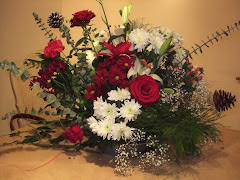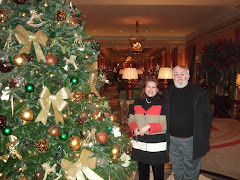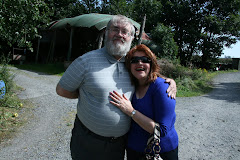Hello ! Well, as you can imagine with the volcano cloud, our flight to Spain was cancelled but it wasn't bad at all, if you are going to be left without travelling, its good when you are left stranded at home rather than abroad so we had a nice night in Liverpool in a room where... oh no ! horror of horrors, Tony Blair had stayed at and a few other people from the world of music who I did not recognize apart from the Beatles. Anyway...we headed to The Walker Gallery in Liverpool the next day, where they are currently having an exhibition from their own collection of ' Women Painters ' which I found very interesting there was a painting of Andromache fainting at the unexpected sight of Aeneas on his arrival by ANGELICA HAUFFMAN who was the daughter of a Swiss painter, she was the first female artist to chanllenge the male monopoly over History painting. History painting took subjects from the bible, history, literature & classical mythology. These subjects were usually deemed too challenging for women. Despite such discrimination, Angelica Hauffmann became a highly respected professional painter with Royal patrons. In 1768, she was one of two female founding members of the Royal Academy of Arts. No other woman was elected as a full or associate member until 1922, when ANNIE SWYNNERTON came to the scene, there is a beautiful painting of hers on show called: ' The Sense Of Sight. Annie was born in Manchester. ( 1844-1933 ) She founded the Manchester Society of Women Painters with the artist SUSAN ISABEL DACRE. In 1895, she was the second, and last woman to sit on the Liverpool Autumn Exhibition Hanging Committee in 1922 and at the age of 78, she was the first woman to be elected as an associate member of the Royal Academy since its foundation in 1768. Her painting ' The Sense of Sight ' ( an angel overwhelmed at the wonder of what they can see, perhaps relates to the importance of sight to an artist and the joy of the visual world.
ELIZABETH- LOUISE VIGEE - LE BRUN (1755-1842)
This artist was taught by her father and financially abused by her art-dealer husband whom she later divorced. She was official painter to Queen Marie-Antoniette but in 1789, the French revolution forced her into exile for 16 years. During this time, she travelled Europe receiving commissions from aristocratic and Royal patrons as a celebrity artist known for her sensitive portraits of women, she was the obvious choice to paint the image- conscious Emma Hamilton, Emma is shown in Naples performing one of the dances that made her famous. It was painted a year, after Emma's marriage in Naples to Sir William Hamilton and 1 year before she met her lover Lord Nelson.
I also found The Dictionary of British Women Artists by Sara Gray, where they had written the name of my ancestor Maria Spilsbury wrong.. they had her as Mary Spilsbury.
Then there was ROSA BONHEUR her father was a social-reformist painter who believed in art education for women. She specialized in painting animals and won fame in her native France with her 5 metre wide painting ' The Horse Fair' it proved so popular, that it toured the U.S. several times, selling thousands of printed reproductions and in Fef 1856 it was exhibited in Liverpool. She gained her sympathetic knowledge of animals by keeping a small zoo and visiting slaughter houses & dissecting animal remains. Mmm. It looks like she took to heart Leonardo's advice ! Then there was ROSALBA CARRIERA she came from an artistic Venecian family. Her father was an amateur artist and her mother was an embroiderer and lace-maker, she started by painting miniature portrait paintings on snuff boxes but moved to life-size portraits in pastel, for which she became internationally reknowned. She was particularly famous among British tourists such as the author and collector Horace Walpole ( 1717-1797) who visited Venice in 1741. So great was the demand for her work among British visitors that she once complained of ' being attacked by the English. ELIZABETTA SIRANI - her artistic skill and beauty brought her European fame and female students. She fed her celebrity with self-portraits, one shown there which was owned by the curator of the Ufizzi collection in Florence. She also entertained visitors to her studio in Bologna with conversation and song. Her father was a painter and all three of her daughters became successful painters, she specialized in religious art. Her early death aroused her father's suspicions that she had been poisoned by her maid. In fact, she probably died from a stomach ulcer brought on by overwork. Or it could have been lead poisoning ! There are paints like White Flake that contains lead. LAVINIA FONTANA she was one of the most successful female artists in the 16th century ( 1552 - 1614 ) and she was the first woman to paint large alterpieces. She was chiefly noted for her portraits. She was trained by her father, a painter from the city of Bologna, known for its support for woman artists. The painting that its on show is based on a drawing by Michelangelo called ' Silentium ' There were a few more. The exhibition is worth seeing.
Subscribe to:
Post Comments (Atom)
































































.jpg)
.jpg)










































9 comments:
That was very interesting, Maria, and I can only assume that the reason women haven't been as prominent in art as men, has been because they've been discouraged and when they have painted something, it's been ignored.
Just as a generalisation, I would expect women to excel men in works requiring fine detail, shades of colour etc but to lag a bit behind men when it somes to perspective, spatial arrangement and so on.
Yes, that is correct. Notice how those women painters who got to be well known, their fathers taught them how to paint and encouraged them to do well. That was a key factor.
The paintings were very fine and delicate. Yes, men seem to have an advantage in perspective and space, although the ones I saw there were quite good on that score too.
I think it used to be part of the "accomplishments" of young ladies leaving finishing school, that they could paint a little, play the piano a little, and so on. But it was only meant to be a little - nothing approaching the point where it might interfere with looking after a husband (although, the ladies who went to finishing school didn't have to look after a future husband since they'd have had servants for that!)
Even the great artists had to have years of training, and this must have handicapped women. I suppose there may have been self-taught artists of the first rank, but I can't at the moment think of any.
Robert, I can't think of any woman who was self-taught and excelled. As you can see.. all these women either had their father to teach them and encourage them or were extremely wealthy with their own means to support a career where you have to work 14 hours a day in a painting and not just a couple of hours once a week. Oh hold on... Beatrice Potter was self taught, she was the daughter of a banker and so was Mary Cassat, the latter one, never married. So she devoted her entire time to painting.
Mary Cassatt was not self-taught, she trained in Paris and she used to hang around with the impressionists painters like Renoir. It was rumoured that she was closed to another Impressionist painter, Degas I think, but Mary remained a spinster all her life.
It's strange, because I wouldn't have thought that painting is something that used to be seen as unfeminine - as opposed to, say, engineering or mathematics, which were seen as masculine activities. Painting isn't the kind of thing that one could easily claim to be a gender thing. You'd have thought more parents would have encouraged their daughters.
Well, anything that could be considered a career was not considered femenine, even if that was painting. If you read the life of Beatrice Potter her mother was always pressurising her to meet eligible bachlors. Beatrice was not interested in marriage until she felt in love with one of the brothers of a publishing company who were responsible for producing her charming illustrated books for children. Unfortunatelly, he died before the wedding and much later, she did marry a solicitor that she had known when she was young. If you look back to Queen Elizabeth I time; the situation about women's emancipation hadn't changed much from this Renaissance period to only 100 years ago. During the Renaissance time, the Queen did not marry, because that would have meant giving all her possessions to her husband and she wanted to rule by herself. If she had married she would have had to relinquish her power and possessions to her husband. It is easy to see. You only have to look at the Islamic culture where in some countries they have to go out with a horrible veil and always escorted by a man. In some extreme cases, only the eyes are visible through a criss-cross mesh. I think that is barbaric! but if there are some dumb females who allow their men to subjugate them in such a fashion... there is nothing to be done.
Their best bet was to have a husband or brother who was interested in the same things as them, then they could make contributions even in scientific things, e.g. Marie Curie and Caroline Herschel.
On the other hand, I don't like the modern tendency of trying to make out that every successful man got vital tips from his wife, e.g. Mrs Einstein helping Albert out with his theory of relativity while she was doing the ironing.
Yes, as a general rule, is best to have someone who is interested in the same thing to accomplish anything, may that be art or science or any endevour. As the saying says:
A single sparrow doesn't make spring!
The impressionist movement would not have happened if these painters hadn't had the same aim of what they wanted to achieve. Movements do not happen with just one person, it requires a group with a similar interests and ideas. I saw a card the other day where it said: Behind every successful woman there is always a cat !
Post a Comment